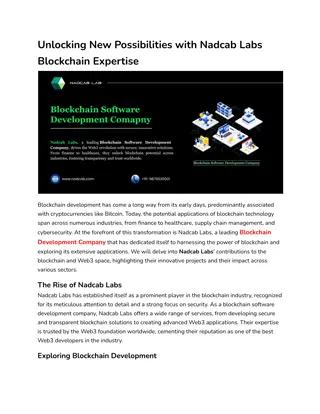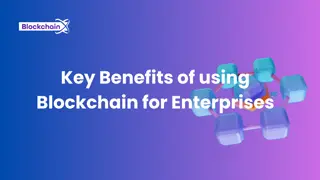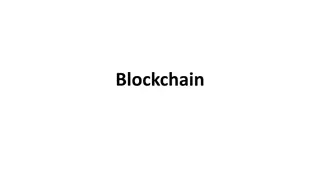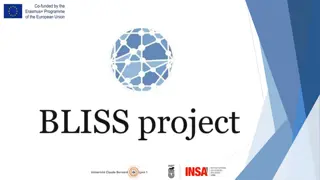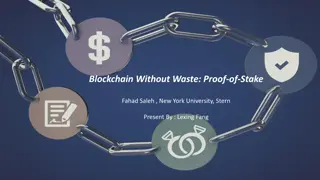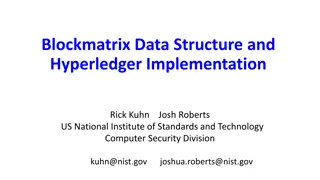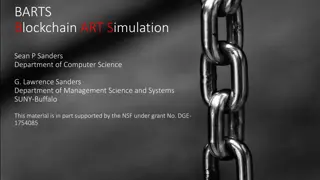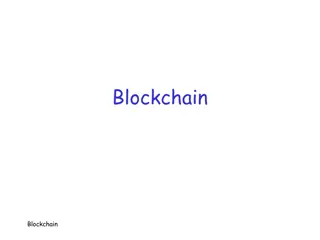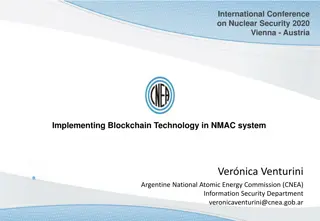Understanding Blockchain Technology: A Comprehensive Overview
Blockchain technology revolutionizes digital transactions through its decentralized, tamper-proof nature. It powers cryptocurrencies like Bitcoin, but its applications extend beyond just financial transactions. The technology ensures security through encryption, replication, and a chain of blocks storing transaction data. Each block contains a unique hash value and references the previous and next blocks in the chain.
Download Presentation

Please find below an Image/Link to download the presentation.
The content on the website is provided AS IS for your information and personal use only. It may not be sold, licensed, or shared on other websites without obtaining consent from the author. Download presentation by click this link. If you encounter any issues during the download, it is possible that the publisher has removed the file from their server.
E N D
Presentation Transcript
David Stotts Computer Science Department UNC Chapel Hill
Blockchain as a data structure
Digital medium of exchange (not tangible) Bitcoin is (not) the first and is most famous (Aug.2008) Bitcoin based on Hashcash Dozens out there now, termed Altcoins Litecoin, Bytecoin, BC Cash, Ripple, Monero, Nexus Kodakoin (company/industry specific)
Traded on exchanges like stocks (and like tangible currencies) Are cryptocurrencies used? Some vendors accept them Many governments are mulling over outlawing or regulating them Private parties can use bitcoin since the ledger is public, and open, and secure So it is more than barter (due to exchanges)
Bitcoin and blockchain are not the same thing Like claiming the voter registration records and Relational DB technology are the same thing Bitcoin (and other many other Altcoins) are implemented on a blockchain Blockchain is being used for many applications others than digital currencies now as well
Blockchain technology is database distributed tamper-proof no central control sequential (temporal) record trace Database ledger for financial transactions in the coin records who gains wealth (mines) records who transfers how much to whom
Tamper proof security via encryption security via replication No central control open software run your own copy of the Bitcoin software (mine, use) Distributed many copies of the chain exist world-wide survives many local failure events (flood, fire, willful destruction, computer outage, etc.) every computer in the network has a copy (almost)
Chain of blocks ( surprise ! ) Block is an encrypted collection of data (in general) For Bitcoin, that data is financial transaction info Each block has a digital fingerprint , a hash value Each block contains (and encodes) the hash of its previous block in chain, and next in chain In COMP 410 terms, a blockchain is a doubly linked list
Hashing used for encryption and security (not access into a hash table) We want a hash to be a fingerprint of some data we want the fingerprint to be unique want fingerprint to be fixed size no matter the data size If dA!== dB (even a little different) we want hash(dA) !== hash(dB) hash(dA) is VERY different from hash(dB) so we cant guess hash(dB) if we know dAand hash(dA) These are called cryptographic hash functions
SHA (Secure Hash Algorithm) is a collection of related cryptographic hash functions SHA-256 generates an almost-unique, fixed size 256-bit (32-byte) hash a one way function it cannot be decrypted back How many 256 bit values are there? 2^256 this is 1.158 x 10^77 compare 10^80 atoms in the known universe Try it online
How many different possible NCAA brackets are there? Let s say in 64 teams even 2^63 9,223,372,036,854,775,808 9.2 quintillion (sounds big but how big?) How big? How many different card shuffles? 52 ! which is 8.0658175e+67 Total atoms in the galaxy? 10^68
Blockchain is a doubly-linked list chain head (block 0000) chain head (block 0000) A link also is SHA-256 hash of the block With a special condition Financial transaction information Financial transaction information Financial transaction information next next prev prev X X Financial transaction information next prev X X next Watch this explanation prev
Every ten minutes, one lucky Bitcoin miner earns a reward for extending the block chain by one block. In 2009, the reward was 50 BTC. Today it is 12.5 BTC. (See https://blockchain.info/q to issue queries about the block chain.) Mining is the only mechanism for creating new bitcoins. The total number of Bitcoins will never exceed 21M. The rewarded miner also receives all (optional) transaction fees in the block. Smallest division of a bitcoin is a Satoshi, 1/100th of a millionth of a Bitcoin ( 0.00000001 of a BTC ) 0.00000001 of a BTC )
Mining costs electricity and hardware My computer will do about 220,000 SHA-256 encryptions per second Mining rigs in common use do about 2.2 billion SHA-256 hashes per second So my laptop does 2.2 gHashes in 2.77 hours One mining rig does the work of 10,000 of my laptops So, I can mine bitcoins on my laptop if I wish there is a chance my snail-paced miner will luckily hit a good block hash BUT that chance is like winning the Powerball lottery
Look at average #hashes must be done to mine a block Demo in JavaScript how many SHA-256 can do per sec My laptop does 10 million per minute 1 million per 6 seconds, is ~170000 per second Measure 220000 per second Mining rigs do 2.2 gHashes per sec to find a new block every 10 minutes So my laptop does 2.2 gHashes in 2.7 hours



